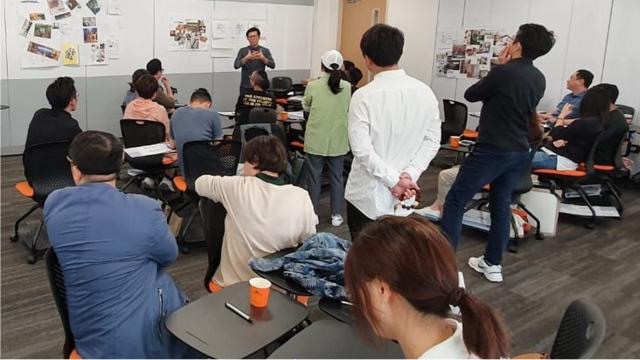
Dionis Soo Wei Qing has a Bachelor of Science (Honours) Degree in Occupational Therapy from SIT. She is currently working in the Acute Stroke Unit of Tan Tock Seng Hospital as an Occupational Therapist, helping stroke patients to rehabilitate and lead fulfilling lives.
SIT is known for its focus on the practical aspect of learning. For Dionis Soo, an Occupational Therapist attached to the Acute Stroke Unit of Tan Tock Seng Hospital, SIT's hands-on, applied learning approach was a huge boon. The precocious 23-year-old MOH Holdings Healthcare Merit Award holder sat down with us to, in her own words, "offer a small glimpse into the many opportunities at SIT".
She shared an inspiring story of a university dedicated to doing its best for its students, supporting them through their studies towards building a successful career.
We understand it was SIT that inspired your interest in Occupational Therapy. How did that come about?
A speaker from SIT came down to my junior college to talk about the various Allied Health programmes that SIT offers, and he shared about Occupational Therapy and what it was as a career. That was actually the first time I had heard of the profession!
What really drew me in was seeing how Occupational Therapy was a "holistic" profession, as it not only considered the physical rehabilitation needs of patients, but also how their mental and social needs impacted their recovery process. I also wanted a job that was focussed on helping others. Occupational Therapy seemed like a perfect fit. So I decided to go for it!
Why did you choose SIT, specifically?
What really struck me was that the Occupational Therapy programme at SIT adopts different pedagogical approaches such as team-based learning and problem-based learning. The quality and clinical relevance of the modules are also ensured, as SIT consults clinical and industry advisors during the process of designing its programmes. Knowing that the quality of the curriculum is ensured through rigorous planning and development gave me a sense of reassurance, leading me to choose this programme offered by SIT.
So, what does being an Occupational Therapist entail?
Currently, I'm working in the Acute Stroke Unit, where I provide rehabilitation to patients who have suffered from acute strokes or other neurological conditions. I conduct functional assessments and explore rehabilitation goals with them and their caregivers. I assess my patients' functioning abilities such as their cognition, strength, sensation, range of motion and how it affects their ability to perform daily activities. I would then carry out the rehabilitation process with patients through the use of daily activities to help them achieve their goals towards independence in daily living. Activities may include personal grooming tasks, dressing, doing laundry and showering. For patients with more lasting impairments, rehabilitation strategies may include activity or home modification, where I work with patients to identify new ways of doing things or make adjustments to their environment so that they can continue to carry out activities that they value. Lastly, I also conduct caregiver training and education so that caregivers, like family or friends, can better assist and support their loved ones who have suffered a stroke.

As part of her work as an Occupational Therapist, Dionis assists patients who suffered from acute strokes by helping them achieve rehabilitation goals like drinking unaided, putting on clothes, or other life tasks.
How did SIT's hands-on approach help you in your transition to the workforce?
For a start, I had clinical placements as part of my education in various settings like paediatrics, mental health and geriatrics. These placements provided me with a better understanding of what to expect as well as a deeper insight into the work and culture.
SIT also has Overseas Exposure Programmes (OEP)! I went to Japan and Hong Kong and it was an eye-opening experience to be able to interact with Occupational Therapy students there and learn more about what can be applied in our local practice.
We hear a lot about the SIT-DNA. How does it apply to your work?
The SIT-DNA provides us with guiding principles that show us how to work and do our best at our jobs. For example: ‘Able to learn, unlearn and relearn'. In my case, I would reflect on what I have observed or done at work (current) and integrate it with the theoretical knowledge gained from SIT along with scientific evidence (past), to identify what I would like to retain or change when it comes to my practice next time (future).
Another SIT-DNA is ‘Catalyst for transformation'. At Tan Tock Seng Hospital, Occupational Therapists are encouraged to join workgroups and service development projects aimed at improving patient care and facilitating their professional development. During this process, Occupational Therapists are effecting positive changes in the workplace.
Lastly, what would you say to someone considering SIT?
Do come down or sign up for our Open Houses and talks, or ask your lecturers if they could invite someone from SIT down to give a seminar so you can learn more about us!
I look forward to welcoming you to the SIT family!
This article was adapted from BrightMinds 2020 with the permission of CareerBuilder Singapore.

![[FA] SIT One SITizen Alumni Initiative_Web banner_1244px x 688px.jpg](/sites/default/files/2024-12/%5BFA%5D%20%20SIT%20One%20SITizen%20Alumni%20Initiative_Web%20banner_1244px%20x%20688px.jpg)

